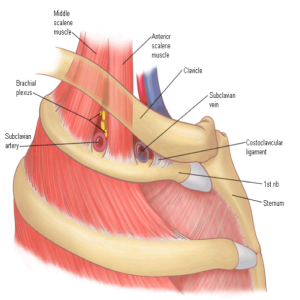 Compression of the nerve, artery, or vein by the anterior scalene muscle pulling on the first rib (pictured) can occur as they exit the chest. This is termed Thoracic Outlet Syndrome.
Compression of the nerve, artery, or vein by the anterior scalene muscle pulling on the first rib (pictured) can occur as they exit the chest. This is termed Thoracic Outlet Syndrome.
Thoracic outlet syndrome can be neurogenic (~90%), venous (~10%), or arterial (<1%). Symptoms of neurogenic thoracic outlet syndrome include pain and tingling that is progressive in the affected arm. This may be exacerbated by increased activity and can often go misdiagnosed. Physical exam findings, MRI studies, nerve conduction studies, and nerve block of the anterior scalene muscle are all used to establish the diagnose of neurogenic thoracic outlet syndrome. Once established, the recommended treatment is first rib resection.
Venous thoracic outlet syndrome also called Paget-von Schroetter disease occurs due to compression of the first rib as it is elevated by the anterior scalene muscle. This is a disease often seen in athletes who are involved in performing repetitive movements such as baseball pitchers, volleyball players, etc., but can occur in older non athletes as well. Often patients present with a blood clot in the vein at the level of compression. We recommend these patients undergo lysis (or breakup) of the clot followed by anticoagulation and ultimately first rib resection. Due to the scarring of the vein that occurs due to chronic compression, all patients Paget Schroetter patients are asked to come back for venous imaging at one month with many requiring an angioplasty of the vein so that it returns to its normal size. This is done in an outpatient setting.
Arterial thoracic outlet syndrome is much rarer and can involve compression of the artery to the point where blood flow is limited to the arm causing hand and arm pain especially with exertion. Many patients will also have an associated aneurysm that will need to be repaired after the first rib is removed.
There are several different ways to remove the first rib. At VSA we prefer the transaxillary approach where the rib is removed through the armpit. While more challenging, this approach is more cosmetic and in our opinion allows for more complete removal of the rib. Patients will often be in the hospital for 2-3 days after the surgery for monitoring and pain control prior to discharge home.
